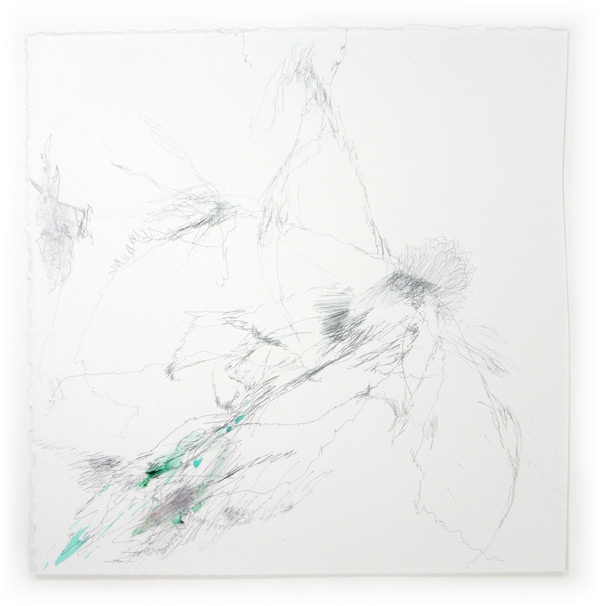Archive for 2007
“I began building on a piece of land” Release
OAKLAND, CA: September 11th, 2007 – The Present Group, a quarterly art subscription service, unveiled an interactive online version of artist Christine Kesler’s “I began building on a piece of land†today. Kesler’s series of 65 drawings is part landscape painting, part collage. The surfaces of some pieces are heavily built up from found bits of paper and debris, while others are delicately rendered in pencil and thin washes. Each describes a specific topography that Kesler encountered on her recent drive across the United States to her new home in San Francisco.
As critic Anuradha Vikram writes, “The result of her labors is a series of psychogeographical maps. Colorful scraps bearing handwriting from a thousand strangers, their most intimate moments momentarily recorded and then tossed aside, are worked into graceful drawings on paper, worked with pen, pencil, india ink, watercolor, gesso and pastelâ€
The 65 pieces, which were commissioned on behalf of The Present Group’s subscribers, are now available for the public to explore online, along with Kesler’s audio commentary describing her journey, an interview, formal critique, annotated links to other resources, and a discussion of the work.
When: Now
Where: www.thepresentgroup.com
A New Way of Supporting Contemporary Art: Subscription Art
The Present Group is like a mutual fund that produces art instead of profits. As a private grant-giving organization, it enables a community of subscribers to support contemporary artists and receive original artwork in return. With The Present Group everyone benefits. Artists gain a new avenue of support. Subscribers receive exclusive and compelling works of art. The world gets an accessible resource and welcoming meeting place devoted to contemporary art.
Contact: co-founder, Oliver Wise, oliver@thepresentgroup.com, 510.419.0616
TPG3 – Discussion
Please use this space to contribute your thoughts and impressions of “I began building on a piece of landâ€
You are also welcome to start a discussion relating to the work in any way.
TPG3 – Annotated Links
Art and Travel
The Art of Travel – Alain de Botton’s The Art of Travel is not a guide to travelling but an exploration of the role of travel, broadly understood, in the lives and work of some eminent artists and writers. He writes “the most effective means of pursuing this conscious understanding [of beauty] was by attempting to describe beautiful places through art, by writing about or drawing them, irrespective of whether one happened to have any talent for doing so.”Mostly focuses on 19th century artists. Buy from Amazon The book was also made into a Television series
Non-Places of Travel in Visual Art – art created with “non-places” as a site for work especially when dealing with themes of lost identity/travel/anonynimity. ” These artists choose them as subjects because, despite their initial bleakness, these non-places have something to say to us. Although a non-place, a lack of place, may signify a loss of identity, it simultaneously creates its own unique experience of new and previously unexpected identities.” by Edita Marelic
Space is the Place – an exhibit in scottsdale, Az that gathers together artists interested in the ulitmate frontier: space travel
 Franz Ackermann – “His work frequently deals with the double side of tourism- the glamour, speed and consumption of international travel but also the detritus, architectural scarring and garbage that it leaves behind, and his installations often take on the appearance of strange advertisements for a global tourism industry run amok.”
Franz Ackermann – “His work frequently deals with the double side of tourism- the glamour, speed and consumption of international travel but also the detritus, architectural scarring and garbage that it leaves behind, and his installations often take on the appearance of strange advertisements for a global tourism industry run amok.”
Angela Bulloch- a review of this Young British Artist’s show where she played a videotape, shot first from inside an airplane then from inside a car, recording the entire journey made by the artist to arrive at the gallery.
William Kentridge - William Kentridge uses drawing as a means for story-telling, often dealing with city life, and propelled by his conscience. He is “interested in…an art of ambiguity, contradiction, uncompleted gestures and uncertain endings.”
.
Christine’s Links:
Christine’s photos from the trip.
The Drawing Center in New York City continues to be one of the foremost institutions in the world to promote experimentation and innovation in the medium of drawing.
On The Road Twelve years ago, this book saw the birth of my wanderlust. Kerouac blessed me with his visions of “the raw body of America itself.”

Nicola Lopez A New York artist who confronts the chaos of urban/human-built landscape, travel and mobility, and information over-saturation. Her experiential mapping resonates with my own work.
An essay on William Least Heat Moon’s novel that led me right up to this trip.
Gordon Matta Clark was a seminal multi-media artist who confronted his own mortality in making enormous marks in the landscape and cityscape around him. Specifically, in cutting open warehouses left abandoned by the city of New York and empty suburban homes; in graceful drawings and photographs that brought to light a bleak reality of the socio-economic scene in America’s 1970s; and in performances- his training and his point of departure was architecture, but his use of materials elevated, reduced, and transformed the very concept of “building.”
.
.
.
.
Introduction to Collecting Works on Paper
Collecting works on paper is a great entry into collecting fine art, especially in the past decade. Collecting works on paper has become very desirable because pieces by emerging artists can be acquired at low price points and there is a lot of innovative work being done in the medium. Collectors are attracted to the uniqueness of works on paper, as opposed to prints, and to the experimental nature, exploration and story-telling through the intimacy of paper.
Works of art on paper include drawings (in any media), collages and other paper-based methods, but not prints (prints are made by drawing a stone or metal surface, not on paper or canvas, from which an image is printed a number of times).
Works on paper are delicate and can be easily damaged, so proper care is a must. When unframed, works on paper must be handled using cotton gloves to protect the paper’s ph-balance from the natural oils in your skin. Poor framing and exposure to strong light are also issues. The paper should be framed using acid-free materials because the acid from regular paper or cardboard will eat into the paper and stain it. You can choose between museum-quality, UV retardant glass or Plexiglas to reduce fading. Cleaning agents should never be used on the glass or Plexiglas because it removes the UV protection and the paper should never be in direct contact with glass; use a spacer. Once framed, a work on paper should not be hung in very humid areas which will cause fungus to grow, this is known as foxing (small brown spots). Also environments that are too dry or cold will cause the paper to become brittle and crack and dust and pollution are also variables that can damage all works of art.
In regards to lighting, if at all possible one should avoid halogen and florescent lights and use tungsten light instead. Works on paper should never be rolled in tubes for mailing or rolled for extended periods of storage. They should be stored flat, between acid-free tissue paper or glassine.
If properly taken care of, works on paper should retain their value and can potentially increase the integrity and synchronicity of a collection overall.
Lauren Gentile, Assistant Director and Director of Sales at Irvine Contemporary is a 2007 graduate of the Sotheby’s Institute in London. She specializes in the economics in the international art market, with expertise in valuation, art advisory services and art collection management. Ms. Gentile holds a Master’s in Art Business degree from SIA London, where she wrote her thesis on fine art as an alternative asset class and fine art investing; the work focused on the recent phenomena of fine art funds. She also has a thorough background in art history, and holds two B.A. degrees in art history and international studies from DePaul University in Chicago. She has studied art history, Italian and German at The School of the Art Institute in Chicago, the Goethe Institute, and the University of Florence.
Building Between Worlds by Anuradha Vikram
contemporary art criticism TPG3
Christine Kesler’s series of drawings is part landscape painting, part collage. The surfaces of some pieces are heavily built up from found bits of paper and debris, while others are delicately rendered in pencil and thin washes. Each describes a specific topography that Kesler encountered on her recent drive across the United States. Her meandering journey from Brooklyn to San Francisco included tours through the backroads of West Virginia, South Dakota and Utah.
 The result of her labors is a series of psychogeographical maps. Colorful scraps bearing handwriting from a thousand strangers, their most intimate moments momentarily recorded and then tossed aside, are worked into graceful drawings on paper, worked with pen, pencil, india ink, watercolor, gesso and pastel. Kesler collects and saves these cast-off pieces from everywhere she goes, combining particulate matter from sites present and past with handwriting and drawing of her own. She observes natural terrain with an architect’s eye, focusing on the uneasy relationship between humans and their environment. The fine pencil lines that run through the frame could be interstate highways or horizon lines, running endlessly through time. The faint outlines of rivers and mountains she draws form an abstracted timeline of separation, change, and renewal.
The result of her labors is a series of psychogeographical maps. Colorful scraps bearing handwriting from a thousand strangers, their most intimate moments momentarily recorded and then tossed aside, are worked into graceful drawings on paper, worked with pen, pencil, india ink, watercolor, gesso and pastel. Kesler collects and saves these cast-off pieces from everywhere she goes, combining particulate matter from sites present and past with handwriting and drawing of her own. She observes natural terrain with an architect’s eye, focusing on the uneasy relationship between humans and their environment. The fine pencil lines that run through the frame could be interstate highways or horizon lines, running endlessly through time. The faint outlines of rivers and mountains she draws form an abstracted timeline of separation, change, and renewal.
The daily practice of drawing became an endurance test for Kesler, demanding discipline and a degree of compulsion. She worked in the car and in motel rooms – the confined spaces that frame the open road. There is claustrophobia evident in the crumpled paper that pushes against the edges of several drawings, and in the rapidly converging perspective of many others. There is also expansiveness, as in the open lines that radiate from a peaceful blue center of water in one drawing. The regular size and shape of each work in the group highlights the tension between these moments.
It is important to understand that these 65 drawings, though distributed individually, are elements of a larger work. Each individual image is a complete portrait of a moment and a place, and as a collection they act as a personal history of transition and discovery. Ownership of one of these works is membership in a community, which begins with the unknown collaborators whose leavings Kesler appropriates and regifts to the owners of her work. She is the conduit for a material connection between two groups of people unknown to one another or to her.
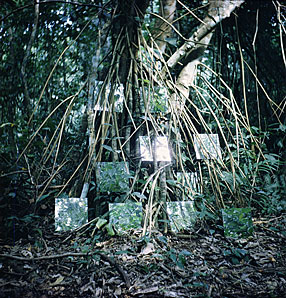 Some precedents exist for Kesler’s collapsing of fragments of time, places, and physical material onto a single plane, yet in her work, these devices are used for narrative and poetic ends. Robert Smithson’s Yucatan Mirror Displacements (1969), in which he used mirrors to disrupt the spatial and temporal landscape of a site, posited the image as both a reflection of the space and time we inhabit, and a permeable barrier collapsing here and elsewhere. This is a concept which Kesler transfers back onto the page, by presenting the remnants of her journeys in a manner that similarly flattens four dimensions. Her take on this is a narrative one, but abstractly so, presenting countless fragments of stories. She has touched down in many places, collecting histories but leaving no mark of her own.
Some precedents exist for Kesler’s collapsing of fragments of time, places, and physical material onto a single plane, yet in her work, these devices are used for narrative and poetic ends. Robert Smithson’s Yucatan Mirror Displacements (1969), in which he used mirrors to disrupt the spatial and temporal landscape of a site, posited the image as both a reflection of the space and time we inhabit, and a permeable barrier collapsing here and elsewhere. This is a concept which Kesler transfers back onto the page, by presenting the remnants of her journeys in a manner that similarly flattens four dimensions. Her take on this is a narrative one, but abstractly so, presenting countless fragments of stories. She has touched down in many places, collecting histories but leaving no mark of her own.
Kesler’s act of collecting the detritus of lives as she travels recalls a documentary tradition in photography, a medium in which she also works. She references Robert Frank’s The Americans as an inspiration, recognizing that seminal book for its geographic range and its penetrating look at all levels of society. Yet Kesler’s work is not documentary, but rather poetry of a visual kind, and as such it also draws on the legacy of the Beat writers’ poetic travelogues. She herself is a poet, and the sparcity of language in her texts is reflective of the spare hand she brings to her art.
This series began its life cycle as an installation, created in a warehouse in Prospect Heights, Brooklyn, which the artist dismantled and recycled into the work we see today. Her exploration is tempered by the anxiety of homelessness. As she took apart and packaged up her life for the move, so she did the same with her art, reflecting a personal experience that resonates with so many individuals who have similarly abandoned one home to establish another. This sense of displacement is at the emotional core of the work; being without a place in the world can be liberating and terrifying. This pervasive feeling of uncertainty deepens her perspective beyond that of a tourist, into that of a modern-day landless settler in search of a new world.
Her impermanence – indeed, her mortality, her humanity – is at the essence of these artworks. Despite our best efforts as a species, that impermanence haunts us all. Perhaps by participating in communities such as the one Kesler weaves, we can each leave our mark.
.
.
.
.
Anuradha Vikram, a curator and writer based in San Francisco’s East Bay, is Program Director at Headlands Center for the Arts in Sausalito, California, where she curates public programs, studio work-in-progress and temporary exhibitions, and supervises the residency and commissions programs. In the summer of 2006, she was Associate Producer of the ISEA2006 Symposium and concurrent Zero One San Jose: A Global Festival of Art on the Edge, August 7-13, 2006, in San Jose, CA, where she co-curated C4F3: The Café for the Interactive City at the San Jose Museum of Art and produced 50 installations and performances by international artists. Prior to the festival, Anuradha was Exhibitions Director at the Richmond Art Center from 2005-2006, where she curated the group exhibition Dress: Clothing as Art and solo exhibitions by Ala Ebtekar, Mads Lynnerup and Beth Cook, and organized numerous others. Anuradha was awarded an M.A. in Curatorial Practice from California College of the Arts, San Francisco, in 2005, and holds a B.S. in Studio Art from New York University, completed 1997.
Anuradha is currently Programs Co-Chair for Northern California ArtTable, and a Curatorial Advisor for Pro Arts, Oakland, CA. She served on the jury for the San Francisco Foundation Murphy and Cadogan Fellowships in June 2006. Anuradha was studio and collections manager for sculptors Claes Oldenburg and Coosje van Bruggen from 1998-2002; project manager for commissions for San Francisco glass artist Nikolas Weinstein from 2002-2004; and an intern in the Department of Painting and Sculpture at the San Francisco Museum of Modern Art in 2004. Recent independent projects include Beyond Explanation: Automatic Abstraction, a group exhibition at the National Institute for Art and Disabilities (NIAD), Richmond, CA, September 5-October 13, 2006; Winter Dreams, Transmissions Gallery, Berkeley, CA, November 1-December 23, 2006; and several reviews published in online and print publications.
Interview with Christine Kesler
artist interviews Artist Interviews others lives TPG3
Christine Kesler was interviewed in Oakland, CA on August 24, 2007
by Oliver Wise and Eleanor Hanson Wise of The Present Group.
Listen: (20:25)
Introduction to “I began building on a piece of land”
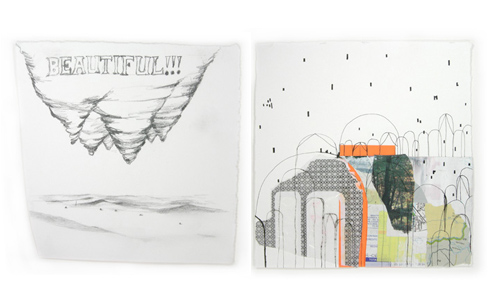
“I began building on a piece of land” is a series of 65 drawings and collages produced by Christine Kesler as she traveled from Brooklyn, NY to her new home in San Francisco, CA.

.
Christine Kesler is an artist who just made the move from Brooklyn, NY to San Francisco, CA where she is pursuing her MFA at CCA.
.
Christine Kesler’s Statement
In this age of immediacy and often-overwhelming wealth of information, the process of combining media is my driver for new discoveries and associations. My work is an investigative process of collecting languages, both visual and written, and finding new ways to map experiences. I gravitate towards items and images with palpable personal associations, such as my own photographs and found printed papers and handwritten notes. The photos document a specific place in time, found handwriting is a symbol for the conversations and secrets of strangers. This work means to explore the nature of material, converting literal objects into a new means of mark-making.
Sourcing found papers and my own drawings and photos, a somewhat cryptic environment emerges, layered with visual representations of various lands and languages, giving evidence of distances traveled by combining raw materials found in the streets of Central America, Europe, and North America. Each work calls into question the process of making art and taking directly from ones surroundings. The viewer is invited into these spaces to find their own relationships between the abstract and the literal, the foreign and the familiar.
The Expo for the Artist and Musician
We are taking part in The 8th Annual Expo for the Artist and Musician on September 15th, 2007. The Expo is the Bay Area’s only grassroots connection fair for independent arts, music and culture — an all-day “Free Culture Fair” featuring more than 120 Bay Area arts organizations, free workshops, children’s activities, our new Community Arts Showcase featuring local music and performance, and hundreds of local artists and musicians. There will be loads of great stuff!
Details: The Expo takes place at SomArts, 934 Brannan St., San Francisco on September 15th, 2007 from 11 am – 6 pm.
Anthroptic goes public!
Ethan and Ben are having an Anthroptic spin-off show at PS122 Gallery in New York Oct. 13th – Nov 4th. Ethan has made big, high-quality prints of the images to hang in the gallery, and with each, he says, “will be some text along the lines of ‘to hear the accompanying story by Benjamin Rosenbaum, call (212)555-5555 ext. 5.’ When that number is dialed, the caller will hear the short story as read by an actor.” Here’s the info:
PS122 Gallery
150 First Avenue
New York, NY 10009
October 13 – November 4, 2007
Opening party: October 13, tentatively 5-7pm
In these Times cites Anthroptic!
 Anthroptic in print!
Anthroptic in print!
In These Times Magazine included a short writeup about Anthroptic in their “Artspace” section of their May 2007 issue. It’s an honor to be included along side such progressive ideas.
Download the May 2007 issue here. Page 41.
Earth-Kiln-Bay-Kiln-Bay Press Release
Land Art Performance meets the digital world. Artist’s work presented online for the public to experience.
OAKLAND, CA: June 26, 2007 – The Present Group, a quarterly art subscription service, unveiled an interactive online version of “Earth-Kiln-Bay-Kiln-Bay†today. For his piece (the second edition of The Present Group) artist Presley Martin collected weathered bricks from a beach in Berkeley, CA. To insert himself into the process, Martin glazed and fired these cast-offs before returning them to the beach and arranging them in a simple circular form. As the tide rose and fell, the waves of the San Francisco Bay continued to weather and re-distributed the bricks. With the help of The Present Group and the United States Postal System, the bricks continue their journey around the country, each stage collected and re-presented to the homes of TPG subscribers. Emily Kuenstler sums up the work in her statement,
“I find Martin’s work especially relevant to the times in which we now live. While the seriousness of world events and crises require daily reckoning with meaning, reclaimed objects inherently illicit new meanings, recontextualized. Rethinking where we have been as a society—and how we have gotten here—is crucial; doing so in a pure, considered aesthetic gesture is restorative.â€
An interactive, digital version of the work, with video documentation of Martin’s performance, is now available for the public online, along with an interview, critique, annotated links to other resources, and a discussion of the work.
When: Now
Where: www.thepresentgroup.com
A New Way of Supporting Contemporary Art: Subscription Art
The Present Group’s quarterly subscription model is a new approach to funding artists while expanding the base of art lovers and collectors. TPG aims to de-mystify the art world one piece at a time, by interviewing the artist, commissioning critics to help subscribers contextualize the work, and by providing a free online resource and discussion area built around each piece. Subscribers can learn about and absorb each piece at their own pace, in the comfort of their own homes, without the intimidation factor of a gallery or museum. As Oliver Wise, co-founder of The Present Group, points out, “It’s the most current contemporary art class you can take.â€
 |
 |
 |
TPG2 – Discussion
Please use this space to contribute your thoughts and impressions of “Earth-Kiln-Bay-Kiln-Bay”
You are also welcome to start a dicussion relating to the work in any way.
“The Present Group presents” 6.27.07 on networked_performance
TPG2 – Annotated Links
FOUND ART:
Duchamp’s Fountain – Generally regarded as the first found art object.
Found Magazine – collects and catalogs found notes, photos, and other interesting items, publishing them in an irregularly-issued magazine, in books, and on its Web site. One of Presley’s found Polaroids is in the FOUND Polaroids book. He has also contributed to the Dirty Found Magazine.
a breif history of assemblage art - “In 1961 the medium of assemblage was given a boost by an exhibition “ The Art of Assemblage” at the New York Museum of Modern Art. William C Seitz, the curator of the exhibition, defined the term when he wrote that the assemblages were entirely or in part, their constituent elements are preformed natural or manufactured materials, objects, or fragments not intended as art materials.
The Art of Assemblage” at the New York Museum of Modern Art. William C Seitz, the curator of the exhibition, defined the term when he wrote that the assemblages were entirely or in part, their constituent elements are preformed natural or manufactured materials, objects, or fragments not intended as art materials.
SWAPATORIUM – Flea markets, thrift stores, antique shops, garage and estate sales, found photographs, collecting, odd finds, swaps and more
Ephemera – “Exploring the world of old paper” – A blog by Marty Weil, an ephemera dealer, consultant, and researcher. Interviews with many different types of collectors.
Junk Pirate – “Found Art Empire”
LAND ART:
Rivers and Tides – a beautiful documentary on Andy Goldsworthy, an artist whose specialty is ephemeral sculptures made from elements of nature. a review of the movie
Richard Long – An artist interested in the documentation of walking, the art of being in a place and subtle interventions inspired from that place. An interview with the artist
Jim Denevan – An artist that makes beautiful sand drawings.
California Current – A 2005 exhibit up and down the Bay area Coastline. The project was initiated to stimulate discussion and awareness in order to foster support for restoration, preservation and sustainable practices for this precious biome, and the greater ocean environment.
“Greenmuseum.org” or “Environmental Art Museum” – a nonprofit, online museum of environmental art, advances creative efforts to improve our relationship with the natural world. They have a large collection of artists making environmental or land art, try to collect writings on the subject, sponsor events, and create a community through discussion, events and workshops.
.
Resources for “Presley Martin’s Innocence” by Emily Kuenstler:
New Crafts Movement – “Of Crafts and Causes” from In These Times magazine – Overview of the crafts movement. Compares Ready-Made magazine with it’s ” college-educated, streamlined, art-school vibe,” to Bazaar Bizarre which is “solidly broke, challenge-the-establishment, rock-kid DIY.” Considers the political influences and possibilites of the movement as a whole.
Relational Aesthetics – “The term ‘relational aesthetics’ was coined in 1996 by French theorist and curator Nicolas Bourriaud to characterize artistic practice in the 1990s. According to Bourriaud, relational art encompasses “a set of artistic practices which take as their theoretical and practical point of departure the whole of human relations and their social context, rather than an independent and private space.” from Wikipedia
Lee Bontecou – “Whether heroically scaled or intimate, Bontecou’s predominantly abstract work has consistently incorporated figurative, organic, and mechanistic references to states of transformation between the natural and the man-made. From her early sculptures—wall-mounted, three-dimensional objects in which geometric fragments of canvas and other materials are stretched over and fastened onto welded metal framework—to the explosive intricacy of her most recent pieces, many of which are suspended in space, Bontecou’s greatest preoccupation as an artist has been to encompass “as much of life as possible—no barriers—no boundaries—all freedom in every sense.†from the Hammer Museum website
A review of her 2004 retrospective by Donald Goddard
Tom Phillips
A HUMAMENT – Tom Phillips’ eternal work in progress. “With Thames and Hudson’s first trade edition in 1980 A HUMUMENT rapidly became a cult classic. It was seen to be a defining product of post modernism linking traditions as various as medieval illumination, experimental poetry and non-linear narrative with the procedures of modern art.” from Humament.com



.
Richard Pousette-Dart – “the youngest of the Abstract Expressionists, had his first solo exhibition at the Artist’s Gallery, New York in 1941 and subsequently showed with legendary dealers Marian Willard, Peggy Guggenheim and Betty Parsons. Introspective and less gregarious than many of The New York School, Pousette-Dart was highly concerned with the spiritual and the role of the unconscious. He drew inspiration from Native American, African, and Oceanic art, as well as European and American artistic trends and the writings of Freud and Jung.”



.
Allan McCollum – “He has spent over thirty years exploring how objects achieve public and personal meaning in a world constituted in mass production, focusing most recently on collaborations with small community historical society museums in different parts of the world.” from his website biography
Louise Berliawsky Nevelson - is known for her abstract expressionist “boxes” grouped together to form a new creation. She used found objects or everyday discarded things in her assemblages or assemblies.


.
arte povera-”denotes not an impoverished art, but an art made without restraints, a laboratory situation in which a theoretical basis was rejected in favour of a complete openness towards materials and processes.”
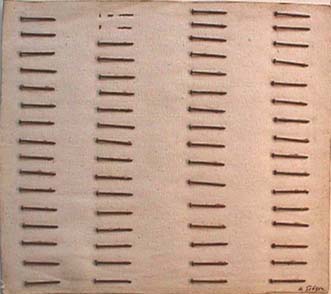

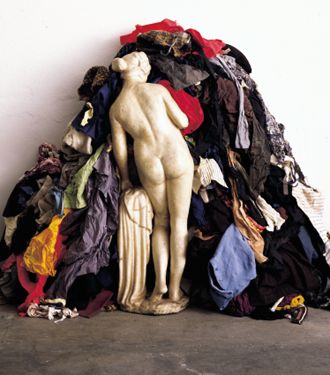
.
Land Art/Earth Art – “The move outdoors also involved a rejection of prevailing modernist ideology, and in particular of the critic Clement Greenberg’s notion that the best art had to concentrate on its own formal properties. Artists working outdoors wanted to reconnect the art world and the real world. Their materials were no longer canvas and paint or marble but dirt, sand and steel — even sun and air.” from Michael Heizer: A Sculptor’s Colossus of the Desert, Michael Kimmelman, New York Times, December 12, 1999
Michael Heizer -”His contribution was to go West. The Abstract Expressionists had linked American art with scale. Jackson Pollock’s paintings were said to refer to the Western landscape. Heizer took the idea to its logical next step. He literally made art out of the Western landscape, replacing scale with size: his works didn’t just allude to big things; they were enormous.” from Art’s Last, Lonley Cowboy, Michael Kimmelman, New York Times, Febuary 6, 2005
Robert Smithson – “a pioneer of earthworks, an influential minimalist sculptor, and a brilliant commentator on contemporary art” from a Moca catalogue
Andy Goldsworthy – “He wants rather to embody the beauty of the act of creation in an exemplary intervention. That is why the often irresistible charm of his work does not derive from the final result, but from the beauty of its creation, the deed to which its owes its existence and that remains visible in the end product.” from Andy Goldsworthy: the beauty of Creation, by Stefan Beyst
Ana Mendieta – an artist in the 70′s and 80′s who was interested in feminist issues and performed/created a series of “Siluetta” where either her body or the form of her body was documented in the natural world.
Ann Hamilton – an installation artist known for her large scale environments with copious amounts of fabric and various other materials (such as wool, pennies, pigmented dust, etc)
.
OTHER:
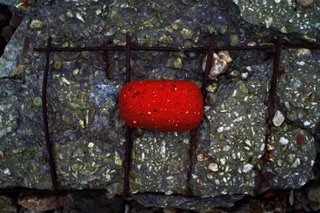 worn bricks post on Over Under- “. . .Another blunt piece of detritus washing up to shore smooth and illuminated in color. These old bricks litter the beach for old men to kick. 150 years ago, not even the largest French fleet could defeat this wall let alone kick it mockingly. Yet, the old man kicks a brick.”
worn bricks post on Over Under- “. . .Another blunt piece of detritus washing up to shore smooth and illuminated in color. These old bricks litter the beach for old men to kick. 150 years ago, not even the largest French fleet could defeat this wall let alone kick it mockingly. Yet, the old man kicks a brick.”
Presley Martin’s Innocence by Emily Kuenstler
contemporary art criticism TPG2
Presley Martin’s oeuvre may be said to exemplify the interdisciplinary pull shared by many young artists today, comprised as it is of several distinct voices: modish, elegant, expressive, and mysterious ceramics vie for attention next to an archive of consumer detritus, painstakingly collected and catalogued in plastic bags. Another trajectory is his text-based work: a wooden specimen case holds found text — excised from the sea of printed matter we produce and discard — each word stuck on the head of a pin, a box poem which rants from within its confine. He acts out of familiarity with topics relevant to both the new crafts movement and so-called “relational aesthetics“; conceptual ritual and post-pop love for civilization’s remnants, its clues re-contextualized, reinterpreted.
 The temptation to experiment with a variety of mediums is great; the challenge to integrate ones predecessors and to retain something resembling an original voice is equally exacting. It is gratifying to see this privilege – that freedom – used so sincerely and to such sensitive ends, as in the case of Mr. Martin. His entire oeuvre bears the mark of originality in its earnest pursuit of an intellectual/ spiritual ideal. I see in Martin’s work a consistent, victorious marrying of beauty and intellectual experimentation.
The temptation to experiment with a variety of mediums is great; the challenge to integrate ones predecessors and to retain something resembling an original voice is equally exacting. It is gratifying to see this privilege – that freedom – used so sincerely and to such sensitive ends, as in the case of Mr. Martin. His entire oeuvre bears the mark of originality in its earnest pursuit of an intellectual/ spiritual ideal. I see in Martin’s work a consistent, victorious marrying of beauty and intellectual experimentation.
It takes (as the Zen saying goes) “Beginner’s Mind,” to approach one’s life and work this way, and he should be commended for making new what he inherits from influences as diverse as: Lee Bontecou‘s fatigued/distressed materials bearing a patina of knowing, of age; Tom Phillip’s word texts that are scraps and tomes at once; and the heavenly painter Richard Pousette-Dart. His use of black glaze also evokes Allan McCollum‘s reliquaries, in which a monochromatic grey-black ceramic finish accents forms, silhouettes and micro-form within a larger whole; and of course, Louise Nevelson assemblage. Again, like Nevelson, his love of found objects is balanced with an aesthete’s sensitivity to form. Presley shares a quality of understatement similar to Italian arte povera, a sculpture movement that arose in response to WWII and used many found objects to evoke existential states. A true descendent of several converging schools of 20th century art, Martin has forged a unique and fresh working method that authentically rearticulates potent phrases from minimalism, conceptualism, and earth art.
When I first encountered Presley Martin’s new piece, “Earth-Kiln-Bay-Kiln-Bay,” I recognized its debt to monumental “Earth Art” from the seventies (Heizer, Smithson) and Andy Goldsworthy. But the difference is that of scale, both metaphoric and physical. Though, for example, Goldsworthy uses delicate materials, his impact is of total aesthetic redesign: the forest is completely transformed into his flag of pattern, whatever he may choose. And the Earth Art of the 1970′s specifically took on the entire landscape, seeking a proscenium for sculpture outside institutional walls. Ana Mendieta and Ann Hamilton might be better comparisons for Martin’s art where natural materials come into aesthetic play in virtue of personal ritual, in service to the artist’s search for meaning. He calls it a piece timed in order “to insert myself into the process.”
If pressed, he says, “I would have to say that the amount of waste we are producing isn’t good. My work, however, is a description of what happens to an object once it’s use value is forgotten; it has a whole second life cracked or stained by its journey to the bay after being thrown away.” He is in good company with Nevelson, who said, “When you put together things that other people have thrown out, you’re really bringing them to life – a spiritual life that surpasses the life for which they were originally created.” The sensibility common across much of Martin’s work could be viewed as belief in the magic of objects. In “The Bay Project,” objects link us to earlier times. In his process-oriented “Earth-Kiln-Bay-Kiln-Bay” the bricks are part of the ritual which renders them more than their mundane former selves, animated like a tribal map in their final configuration. His text pieces are perhaps the most spare and really highlight the enchantment aspect of his treatment of everyday things: simply by cutting and rearranging the language of advertising circulars and magazines, they become anguished and florid spells/poems.
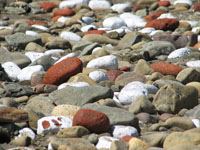 At some point walking the stretch of Bay beach in Berkeley CA, Martin saw the strewn bricks washed up that would eventually be incorporated into “Earth-Kiln-Bay- Kiln-Bay.” In this most recent piece, he calls the original bricks “virgin” in contrast with their white, ceramic-glazed cousins which reappear on the beach, marking the time that has passed and highlighting their man-made status among “real” rocks. So, from the suggestion of production intrinsic in consumer detritus, the artist Martin powerfully inhabits the beach, and personalizes the production of the bricks themselves, becoming a maker of what is found there. This potent metaphor acts in counterpoint to the generally thoughtless chain of consuming and casting off.
At some point walking the stretch of Bay beach in Berkeley CA, Martin saw the strewn bricks washed up that would eventually be incorporated into “Earth-Kiln-Bay- Kiln-Bay.” In this most recent piece, he calls the original bricks “virgin” in contrast with their white, ceramic-glazed cousins which reappear on the beach, marking the time that has passed and highlighting their man-made status among “real” rocks. So, from the suggestion of production intrinsic in consumer detritus, the artist Martin powerfully inhabits the beach, and personalizes the production of the bricks themselves, becoming a maker of what is found there. This potent metaphor acts in counterpoint to the generally thoughtless chain of consuming and casting off.
One can often glean – but not quite define – sincerity in a given artist’s work. It is as if they would do just what they are doing even if everyone stopped watching. This is so palpable in some (including Mr. Martin’s work) that it enriches the viewer, like a quiet conversation. To borrow and patchwork together many styles for the sake of relevance or innovation would never nourish the maker the way a gentle digesting of life itself does. In this way the art accrues meaning from contemplation, and observing it makes the world altogether clearer. I find Martin’s work especially relevant to the times in which we now live. While the seriousness of world events and crises require daily reckoning with meaning, reclaimed objects inherently illicit new meanings, recontextualized. Rethinking where we have been as a society -and how we have gotten here – is crucial; doing so in a pure, considered aesthetic gesture is restorative.
.
.
Emily Kuenstler is an artist and writer living and working in the San Francisco Bay Area. Her writings have appeared in AfterImage and Stretcher.org.
Interview with Presley Martin
artist interviews Artist Interviews TPG2
Presley Martin was interviewed in Berkeley, CA on April 22, 2007
by Oliver Wise and Eleanor Hanson Wise of The Present Group.
Listen:
Read:
Oliver Wise: Let’s start with a little bit of your background: how long you’ve been making art, and how you sortof came to it.
Presley Martin: I guess it started in college. I was a science major starting out. I gradually started taking more and more art classes in ceramics in particular, and art history too. And then I got frustrated, left school, and just tried to work as little as possible and pursued what I was interested in doing.
When I was working in Richmond I would ride along the bay on my bike. I started noticing the garbage washed up. I started collecting it. It was too interesting to pass up. So I started out with mostly plastic stuff. I was interested in the fact that you come out to a really natural area, but then you find brightly colored, perfectly round shapes. So I was collecting those when I started out.
I’ve always been interested in ceramics, and making some ceramic sculpture too. So when I first found the bricks, when I realized I could glaze them, it was an interesting way to sortof enter that process of things that get discarded and make it to the bay. Cause with the plastic, I was always thinking of if there was some way I could mark the plastic somehow. But then when I realized I could glaze the bricks, take them out of here, glaze them and sort of add another layer, insert myself into that process.
Yeah in general I’m interested in things that have had a use, and that people discard for whatever reason, or it blows out of their car. So I’m interested in a second life of these things that … when you’re done with your plastic water bottle, you usually don’t think about it, but it goes somewhere. So I guess the Bay was particularly interesting because it seems like it’s this huge collector for most of the people that live in the area. So anything that doesn’t go to the landfill, anything that escapes that stream, most likely will end up here.
Eleanor Hanson Wise: And isn’t that because a lot of the storm drains just wash right out into the bay?
PM: Yeah pretty much every storm drain just goes straight to the bay or straight to a creek that goes to the bay.
EHW: Do you view the bay itself as a sort of collaborator with you, with its own process of sorting and collecting?
PM: I guess. I mean not in a personal way. But it does.. Yeah, it definitely helps. Beause I used to collect just stuff off the street, mostly paper. But the bay definitely makes it easier, it concentrates things along the tide lines especially. That’s what I’ve found too, the different spots contain different things. Like here it’s the bricks, but at other places I haven’t really found any bricks. Other places have more plastic forks, or more gum, or you know…
EHW: What about photography, because you do a decent amount of photography as well, do you find that as sortof another way of collecting and organizing events or places or whatever, or do you see the photos as a more a work on their own?
PM: Not really, because I’ve never had any real formal photography training or anything. So I guess it has been another sort of collection. I do have a collection of found photographs, just ones I find on the street.
EHW: Seems like time is a big thing for you: progression through time.
PM: Yeah it is. It’s not actually something I really think about too much, but it always is an element. I guess it follows my natural rhythm of my life.
EHW: What do you mean?
PM: Well in terms of collecting stuff. For a while I just fit it in after work, or going to work, or whatever. So it’s always been on my scale. Whatever I could carry in my backpack on my bike.
But time, I’m definitely interested seeing how things change over time. With the bricks, I’m interested how the glaze is going to wear off, how the tide and the water is going shift them around. I put them in here and let the bricks in here and let the waves work on them is the same way as putting the clay and paper together and letting it work on its own.
But even with that stuff I’d like to get a sort of natural process involved. So I’d pour out liquid clay onto paper. So as the… when clay dries it shrinks, so it forms…the paper and the clay form together. So as they dry the clay shrinks, the paper tends to curl or buckle and then I, after it dries, extract them from the paper and fire them. And I guess in that way I tend to accumulate a bunch of those bits first and then make some sort of arrangement. You know I’ve done stuff where I ‘ve got a bunch of forks, and I have them in a progression from whole forks all the way down to single tines.
EHW: In a lot of ways your work could be compared to that of Richard Long, Smithson, or Goldsworthy. Do you see your work as a continuation of those Land Artists?
PM: Yeah, I really like their work, but I’ve always shied away from being that. They seem so serious. There’s like this purity that they strive for that just doesn’t really feel right to me. But I’ve always really been interested in the nature in the city. City parks. When I lived in Pittsburg, I was amazed that there were these beautiful parks. And you could go, just find a spot, and sit all by yourself. You’re in the city, but you can sit amongst the trees, and be totally by yourself.
EHW: Do you see your work as more performance based almost, or more as finished pieces, or are they more a thing that just doesn’t really have an end?
PM: Hmm. I never thought of it as performance until seems like four years ago. I took this class with this group of people and we were talking about presenting work and stuff, and it came up about my work that it was like this performance of going out and collecting and arranging this stuff. So since then I have thought about it more in that term, but it hasn’t really affected the way I do it.
So now I’m going to come back, over the next couple days, and see what’s going on. The performance of the elements. But I guess I had always had this notion of performance art in a gallery, you know Joseph Beuys living with wolf for a week or whatever.
I guess over the years I’ve been doing this, I feel like I’ve gotten more comfortable with it. And it’s more of who I am now, which is a pretty quiet person. So I’m getting, getting to that place, you know, of expressing who I am.
Introduction to Earth-Kiln-Bay-Kiln-Bay
 Earth-Kiln-Bay-Kiln-Bay was created during the spring of 2007 by Presley Martin and the San Francisco Bay. Martin discovered a beach in Berkeley, CA strewn with weathered bricks. He collected these cast-off bricks and brought them to his studio where he glazed and fired them white. He then returned them to the beach where he made a simple circular arrangement. As the tide rose and fell, the waves of the Bay covered and re-distributed the bricks throughout the beach. With the help of The Present Group and the United States Postal System, the bricks continue their journey around the country, each stage collected and re-presented to new homes.
Earth-Kiln-Bay-Kiln-Bay was created during the spring of 2007 by Presley Martin and the San Francisco Bay. Martin discovered a beach in Berkeley, CA strewn with weathered bricks. He collected these cast-off bricks and brought them to his studio where he glazed and fired them white. He then returned them to the beach where he made a simple circular arrangement. As the tide rose and fell, the waves of the Bay covered and re-distributed the bricks throughout the beach. With the help of The Present Group and the United States Postal System, the bricks continue their journey around the country, each stage collected and re-presented to new homes.
Earth-Kiln-Bay-Kiln-Bay resulted in an edition of 65 signed wooden boxes that contain three bricks: one brick from each stage in the project, each in its own felted compartment. Also included on the inside of the lid is a video document of the project that features an interview with the artist.

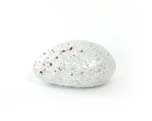
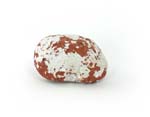
Presley Martin is an artist living and working in Oakland, California. His work elevates the ordinary objects and humble phenomenon he encounters in everyday life. He is especially interested in exploring the ambiguous space between accidental and planned, man-made and natural.
Recap: Speaking the Art World into Existence
We wanted to give a little recap of our participation in the discussion at the Yerba Buena Center for the Arts put on by The Collective Foundation. We were one of 10 projects and organizations that “exemplified a more democratic, people-powered art world and employ strategies of collective contribution, crowd-sourcing, and alternative or informal economies.” It was exciting to find such strong kinship with people from across the country who were all thinking up new ways to support the arts, trying out new methods of funding, and rethinking the artist/commodity world in general. Many of the groups were very new, like us, but a few were more established. It was a really inspiring night.
Here are links to the other groups involved:
Copy-Art.net
Fine Art Adoption Network
Cadre Art Grants
Service Works
InCUBATE
Orchard
MutualArt
Tiny Showcase
The Center for Cultural Innovation (CCI)
The Present Group – Call For Submissions
Who we are:
The Present Group is a subscription art service. TPG subscribers receive 4 original pieces of art from 4 different contemporary artists in one year. Each work is reproducible in intent; the piece cannot lose quality by being reproduced. The edition is limited to the current number of subscribers, plus a small percentage for new subscribers and a small stock of back issues.
What we are looking for:
Proposals for projects that are reproducible in intent. Each piece can be a limited edition, an artist multiple, or either a part of or a document of a larger work. Our current edition numbers are under 100. We choose based on the piece’s Visual, Conceptual, and/or Experiential interest. The project will be made exclusively through The Present Group. We understand that similar themes and images may be used throughout your other work, however you agree not to create the exact project in the same form again.
Appreciation for Selected Artists:
• $500 (This is an honorarium; we cover the costs of production)
• 4 of the produced work for your own collection or to sell on your own.
• A captive audience of Art Lovers and Collectors
• All the contextual information we create for your piece, including artist info, critiques, and video
will remain free on-line as long as TPG exists
Do you have to make them all yourself?
No. You don’t have to be able to physically make them all yourself. We‘ll work with you to have them made, or help you make them. It is not a requirement that you have worked on this scale before.
How does this “working together to get things made†work?
We can’t give you a definite answer here, as every piece and every person will be different. But in general, we will find vendors, organize labor, figure out production methods. Your timely approval will be necessary so that we will be able to maintain your vision and stick to our quarterly schedule. If chosen, you will be asked for an artist statement, and for some or all of the following: to be interviewed, to provide information to someone writing a piece about you or your work, to be videotaped during a studio tour or lecture, etc.
.
SUBMISSION GUIDELINES:
Your proposal should include:
• Contact Information: Name, Address, Phone Number, E-mail, Website (if it applies)
• Project Proposal:
1. What you want to do.
2. How this work will relate to/expand on current themes in your work
3. Anything (sketches, photos. . .) to help you explain your idea.
• Links to Artist Resume, Statement, Work Samples
Deadline:
The Present Group has a rolling submissions policy; we review proposals four times a year. Our next review date is AUGUST 8TH, 2007. Everyone who applies will be contacted by e-mail.
Email guidelines:
submit[at]thepresentgroup.com
Include all of your contact information in the body of your email.
You may also include your project proposal in the body or .PDF.
We much prefer links to web sites or files. If you must use attachments, limit it to three. We will not open more. We prefer .PDFs or .JPGs. We will not accept attached video.
Snail Mail guidelines:
The Present Group
Attn: Submission
593 8th Street #3
Oakland, CA 94607
Send us anything you feel will help us understand your background and/or proposal. We will accept any form of media. If you’d like your sample material returned please include a SASE with proper postage.
.
.
Download guidelines here (pdf)
Anthroptic – Epilogue
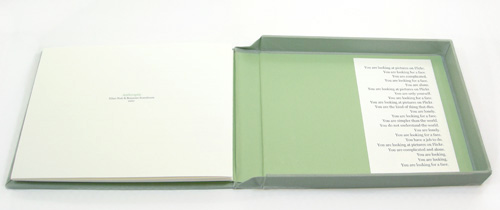
By Benjamin Rosenbaum and Ethan Ham
You are looking at pictures on Flickr.
You are looking for a face.
You are complicated.
You are looking for a face.
You are alone.
You are looking at pictures on Flickr.
You are only yourself.
You are looking for a face.
You are looking at pictures on Flickr.
You are the kind of thing that dies.
You are lonely.
You are looking for a face.
You are simpler than the world.
You do not understand the world.
You are lonely.
You are looking for a face.
You have a job to do.
You are looking at pictures on Flickr.
You are complicated and alone.
You are looking.
You are looking.
You are looking for a face.
LINKS
Archives
Lego Hello World
I wish all my printers were made of legos.
LIFE photo archive hosted by Google
Images from Life Magazine going back to 1860′s, hosted by Google
Coming Face To Face With The President
Well crafted story about an under-heard point of view.
In California, Pot Is Now an Art Patron
A new funding source for the arts – reaping big rewards and funding many projects. It’s pot.
Notes on Portraiture in the Facebook Age
Celebrity Book Club: A List to End All Lists
Because, well, it’s sortof awesome.
Are "Artists' Statements" Really Necessary?
The pros and cons about that nemesis for most artists.
This to That
You tell it what you’ve got and it’ll tell you what to glue them together with.
Work of art: Online store for buyers, sellers
Not the TV show! Kelly Lynn Jones from Little Paper Planes is interviewed on her project, gives us a cheat sheet to local affordable art resources.

